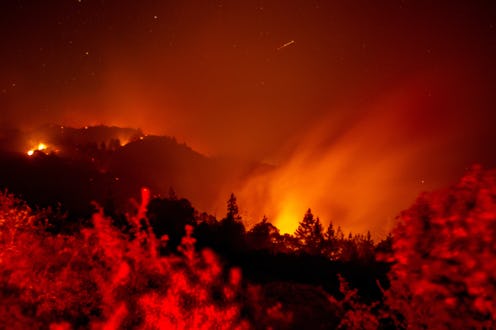Life
The 10 Things Experts Say You Need To Take During An Evacuation
How to prepare for an emergency.

In forcing thousands to leave their homes, the wildfires raging from Southern California all the way up to Washington state have many people asking: When you need to evacuate, what do you take with you? Whether forced to leave home because of a fire, a flood, a hurricane, or a tornado, there are certain things experts recommend you take in an evacuation.
Wildfire season is just beginning, and already 2020 has seen a record of nearly three million acres burned in California alone. According to the National Interagency Fire Center, 87 large fires have burned nationally this year across California, Oregon, and Washington state. NPR reported that tens of thousands of people were ordered to evacuate Medford, Oregon, on Sept. 9, with the combination of intense dry heat and strong winds fueling the blazes.
In the midst of an emergency, it can be difficult to think things through clearly and completely, which is why state and federal disaster response agencies recommend planning for a potential evacuation well in advance. So, what's vitally important and what can be left behind? While ensuring the safety of your family should be priority number one in an evacuation, you'll want a checklist of material items at the ready (and, ideally, a "go bag" of the things you absolutely can't forget.)
Here are the things it's recommended you take from your home if you're ever forced to evacuate.
Pets
For many, pets are a part of the family. So, it goes without saying that they should be at the top of the list when it comes to what you take with you to safety.
To save time when an emergency strikes, the Humane Society recommends creating a pet evacuation kit in advance. Stock it with food for your pet and any other supplies you may need for them like a leash, carrying kennel, water, toys, and blankets.
Identification
Although they are items we carry with us nearly every day, it can be easy to forget the basics when rushing out the door in a mandatory evacuation. It's important to bring forms of identification with you if you're forced to flee your home. Pack your driver's license, passport, and any other critical identification documents you have. For trans folks, that might also make sure you have any therapy letters or court-order petitions you might need to back up your request for name and gender marker changes.
Experts at Everplans, a tech tool designed to help users create secure, digital archives, also recommend keeping some form of proof of address — such as a utility bill — in your evacuation pack. You may be required to show it when looking to gain help or access to your neighborhood after the disaster has passed.
Cash & Credit
The Department of Homeland Security, which runs Ready.gov, a national public resource to help Americans prepare for and respond to emergencies, recommends keeping cash on hand for emergency situations, as ATMs may not be accessible in an emergency and stores may be unable to take credit cards due to power or system outages.
It's also recommended to take your checkbook and at least one credit card with you in case you need to check into a hotel or make any emergency purchases.
Important Documents
Be sure to grab any important documents like birth or marriage certificates, social security cards, wills, property deeds, or rental leases, and any other legal, financial, or insurance-related paperwork on your way out the door. While you may not need all of these documents in the immediate aftermath of an emergency, you may find them difficult to replace.
Keys
When evacuating, you should try to bring any important keys with you, such as those to your home, vehicles, office, storage units, or safe deposit boxes.
Any Needed Medications Or Medical Supplies
While it may sound obvious, medicine can easily slip people's minds while evacuating. Taking any and all needed prescription medication for you, your family members, and your pets is critical, according to Ready.gov.
Any prescription or over-the-counter medicine used regularly, semi-regularly, or strictly in emergency situations by anyone in your family should be taken in an evacuation. This includes EpiPens, inhalers, birth control, insulin, or hormones. You should also take any needed eyeglasses or contact lens supplies.
Hygiene Supplies
While you won't want to weigh yourself down with every item in your bathroom, it's not a bad idea to have a few basic hygiene supplies ready to go in your evacuation kit. Pack things like wet wipes or hand sanitizer, a toothbrush, extra underwear, tampons or menstrual pads, and diapers, if needed, in your preparedness kit so they're easily accessible in an emergency situation.
Basics
Other basic supplies that Ready.gov recommends you take with you in an evacuation include some food and water, comfortable shoes, at least one change of clothing, a jacket for each family member, flashlights, batteries, a hand-crank radio, and sleeping bags or blankets. Don't forget spare masks, both N95 with valves that block dust, as well as cloth or disposable face coverings that prevent the spread of coronavirus.
Electronics
While it's not recommended to risk your personal safety for a few electronic items, grabbing your phone, tablet, laptop, external hard drive, and any needed chargers if time allows could save you a headache in the future. It may also make it easier for you to contact others.
Irreplaceable Comfort Items Or Keepsakes
Grab comfort items and sentimental keepsakes if time allows. Focus on things that are irreplaceable, like photos with no digital copies, family heirlooms, a child's favorite toy, or valuable collectibles. If your area is under threat of evacuation, keep these articles packed and ready to go so you're not searching for them in an emergency situation.
This article was originally published on